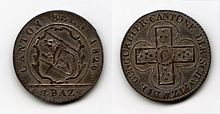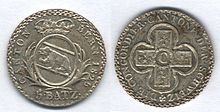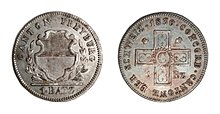Chunk



The Batzen is a historic Swiss and South German coin .
history
The Batzen was minted for the first time in 1492 and subsequently until 1850 in Bern . Valerius Anshelm said it was named after the canton's heraldic animal, the bear or "Bätz", which was embossed on the reverse of the coin. However, the origin of the term is not certain. The value of a Bernese lump was the equivalent of four cruisers. Since the gulden was worth 60 kreuzers , a lump also corresponded to a fifteenth of the gulden . Later there was also «grossi» (fat, i.e. groschen ) at 5 chunks.
Other places in the Old Confederation and some southern German states soon followed Bern's example. The Batzen became a widespread intermediate currency between the numerous large and small silver coins circulating in Europe. Since some of the southern German lumps were of very different quality, the diets of 1522 and 1524 spoke out against these coins. In southern Germany they were minted until 1536, but were forbidden by the Imperial Coin Order in 1559, but were also used as a currency denomination in 1564 (e.g. in Nuremberg). In Switzerland, however, the Batzen remained unchallenged.
In the case of some so-called Kipper coins , however, the lump was used to name these interim coins . In the time of money falsification, the tipper and wipper era , for example in Thuringia in the mints of Gotha (1621–1623) and Weimar (1619–1622) a. a. Kipper coins minted as three and six-part coins. The minting could not be objected to, because it was not taler coins or their parts that had to comply with the imperial coinage order, but land coins .
Even after the Munich Mint Treaty of 1837, Batzen were minted as dividing coins with a value of four cruisers in some member states, for example in the Free City of Frankfurt . The coins were in use until the introduction of the mark . In 1873, the increase in the price of beer by the Frankfurt breweries from 4 to 4½ kreuzers triggered the Frankfurt beer riot , which began with the demand for Batzebier and led to serious social unrest.
The lump was originally minted in silver , but from the 17th century in billon . The value of the lump differed over time depending on where it was minted. In the early 18th century the whole Batzen stood at five Kreuzers (1/12 Reichsgulden), the regular Batzen at four Kreuzers, the Basler and Zurich Batzen reached 1/18 Gulden, the St. Gallen Batzen 1/17 Gulden.
When a Swiss single currency was first introduced by the Helvetic Republic in 1798–1803 , the Batzen was also integrated into the system. One franc was equivalent to ten pounds, and one pound was ten cents , with ten Swiss francs being equivalent to a Louis d'or .
After the end of the single currency, coinage sovereignty returned to the cantons, some of which retained the decimal division between francs, batzen and rappen (Aargau, Basel-Stadt, Bern, Freiburg, Lucerne, Solothurn, Unterwalden, Uri, Waadt, Wallis, Zug) . Only in the canton of Neuchâtel was a franc worth 10½ batzen. The other cantons introduced currencies with a guilder- shilling or florin - livres system. In 1850, the Batz era ended with the introduction of the new Swiss franc as the single Swiss currency. It should be noted that an old franc did not correspond to a new franc. Seven chunks were exchanged for one new franc in 1850.
Younger and modern word usage
After the introduction of the franc, the word "Batzen" was unofficially transferred to the ten centimes piece of the new currency, which it most closely matched in terms of value. The twenty centime piece was appropriately called "Zweätzler":
"I had a two-seated dog in my sack, which I found on the kitchen table after breakfast and which I put in my pocket without telling my mother."
However, this meaning is now out of date. Apart from the occurrence in a number of - often also outdated - idioms, "Batzen" or in children's language "Batzeli" today stands for any coin or for an unspecified amount of money, compare, for example, "a nice lump of money" (i.e., "a nice sum of money") , “Göttibatzen” (in Switzerland: ‹amount of money received from the godparent›) or in a “half-batz collection”. Although there have not been half a lump since the currency reform of 1850, it was initially clear with this collection for the Basel Mission , introduced on the initiative of Karl Sarasin in 1855 , that it was five cents and thus an amount that would be donated to poor people was still within the realms of possibility. The Halbbatzenkollekte has survived into the 21st century.
The word Batzen also became known in German-speaking countries through the folk song Ein Heller and a Batzen , which were both mine. The text from 1830 comes from Albert von Schlippenbach . In addition, it appears in the original version of the fairy tale Hansel and Gretel by the Brothers Grimm , in which it says, among other things: “And when the full moon had risen, Hansel took his little sister by the hand and followed the pebbles that shimmered like new chunks and showed them the way. "
The old Bozener Weinschänke Batzenhäusl can also be traced back to the word Batzen as payment for the wine sold here.
literature
- Anne-Marie Dubler : Batzen. In: Historisches Lexikon der Schweiz ., With further references.
- Batz II / Batzen . In: Schweizerisches Idiotikon . Volume IV. Huber, Frauenfeld 1901, Col. 1964–1976 (with numerous information on both historical and dialectal usage).
- Chunk . In: Prussian Academy of Sciences (Hrsg.): German legal dictionary . tape 1 , Issue 8 (edited by Eberhard von Künßberg ). Hermann Böhlaus successor, Weimar 1962, OCLC 934824402 ( adw.uni-heidelberg.de - first edition: 1931 or 1932).
Web links
Individual evidence
- ↑ See Duden online and the explanations in the Schweizerisches Idiotikon (Volume IV 1968–1969) .
- ↑ Doris Wolfangel: Dr. Melchior Ayrer (1520-1579). Medical dissertation Würzburg 1957, p. 19 f.
- ↑ Half-Batz Collection: collection of donations, proposed by Karl Sarasin from 1854 on . Origin of the half-bunch collection. Retrieved July 3, 2011 .
- ↑ s: General German Kommersbuch: 117

